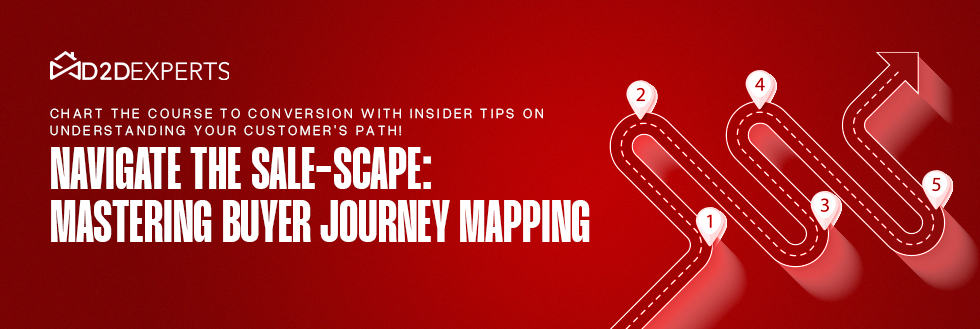Buyer journey mapping is a strategic process of visualizing the path taken by your buyers from their initial awareness of your brand to the ultimate purchase decision. This map reveals fundamental interactions, emotions, and decision points your buyers experience.
It’s not merely a storyline but a powerful tool to understand and predict customer behavior, enabling you to tailor your sales approach for increased conversions.
Why is Buyer Journey Mapping Important?
In today’s competitive market, understanding your buyer’s journey is more crucial than ever. It allows you to:
- Personalize your sales approach: By understanding your buyer’s needs at each stage, you can tailor your messaging and solutions to their needs.
- Identify gaps in your sales process: Mapping the buyer’s journey can highlight touchpoints where potential customers may be dropping off, enabling you to take corrective measures.
- Enhance customer experience: By aligning your sales process with the buyer’s journey, you can significantly improve their experience, leading to higher satisfaction and loyalty.
Mastering Buyer Journey Mapping in 7 Steps
Navigating the complex sale scene requires a deep understanding of the buyer’s journey. This journey is your customers’ path from recognizing a need to purchasing. Mapping this journey effectively can significantly enhance your sales strategy and content alignment. Here’s a seven-step framework to master buyer journey mapping:
1. Define Your Buyer Personas
Begin by creating detailed buyer personas. Understanding your buyer’s challenges, questions, and goals is essential for an accurate buyer journey map. This involves deep research and possibly conducting interviews to gather rich insights. These personas are the foundation of your journey map, guiding every step of the process.
2. Identify Buyer Persona Challenges
In the awareness stage, identify the obstacles preventing your buyer from accomplishing their goals. What triggers their realization of a problem? Document all potential challenges and concerns that bring this issue to their attention. For instance, if you’re selling IT services, a buyer persona like an IT Director might become aware of a need for better cybersecurity after experiencing a breach.
https://thesamtaggart.com/blog/adapting-when-selling-to-different-sales-personality-types/
3. Explore All Possible Solutions
During the consideration stage, think about various solutions your buyer might contemplate. What different approaches could they consider? Address the buyer’s top-of-mind questions and concerns regarding these solutions. For example, a buyer aware of their cybersecurity needs might explore different software solutions or consider partnering with an IT service provider.
4. Analyze Competing Solutions
In the decision stage, list competitors offering similar solutions. What factors will the buyer consider when evaluating these options? For instance, when considering cybersecurity solutions, the buyer might assess costs, functionality, and ease of use in software or evaluate the expertise of different IT service providers.
5. Identify Friction Points
After mapping the awareness, consideration, and decision stages, identify potential hurdles in the buyer’s journey. What challenges might they encounter that could impede their progress or decision-making? By pinpointing these friction points, you can create content that helps and effectively sells by smoothing the buyer’s journey.
6. Audit Existing Content
Examine the content you already have, like blogs, ebooks, and guides. Determine where each piece fits within the buyer’s journey. Does it address high-level pain points, focus on specific solutions, or sell your business as the right partner? This audit is crucial in understanding your existing content’s role in each stage of the journey.
7. Create Content to Fill Gaps
Identifying gaps, especially in the consideration stage, with understanding where your existing content fits. A strategic approach is to start creating content for the decision stage first, then move backward to the consideration and awareness stages. This ensures a focused approach to converting buyers into customers and provides a clear “next step” for each new piece of content.
Implementing the Framework
Implementing this framework requires careful planning and a deep understanding of your buyer’s needs. Continuously refine your journey map based on feedback and changing market conditions. Use this map as a guide to create relevant, helpful content that reduces friction in the buyer’s journey. This approach leads to satisfied customers more likely to promote your brand.
In conclusion, mastering the buyer journey mapping is not just about understanding your customer’s path to purchase; it’s about aligning your sales and marketing strategies to meet their needs at every step. By following this seven-step framework, you’ll be well-equipped to navigate the sales verse effectively, leading to improved customer relationships and increased sales success.
You might be wondering, “What’s the next step? How do I apply all these insights practically?”
Well, that’s where the Business Bootcamp comes into play.
Think of it as your hands-on guide to bringing those buyer journey maps to life. The Business Bootcamp’s effective sales training ensures that we don’t just talk theory; we walk you through applying these concepts to real-world sales scenarios. Over two engaging days, you’ll learn how to:
- Fine-tune your approach to finding and nurturing top talent with a keen eye on the personas you’ve mapped out.
- Tailor your training methods to address the specific stages of the buyer’s journey, ensuring your team knows how to engage effectively at each point.
- Create a motivating, rewarding culture that mirrors the insights and anticipations you’ve gathered from understanding your buyers’ paths.
Reserve your spot now and leap from mapping to mastering the buyer’s journey with us.
A digital marketing professional specializing in content-based functional areas - Ahsan Zafeer is driven by a never-ending passion for developing, nurturing, and strategizing key content aspects. He writes extensively on tech, digital marketing, SEO, cybersecurity, and emerging technologies. He is also a digital marketing strategist and freelance consultant for globally oriented organizations.


